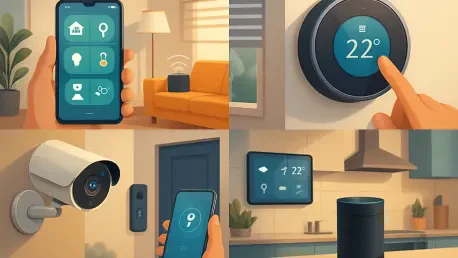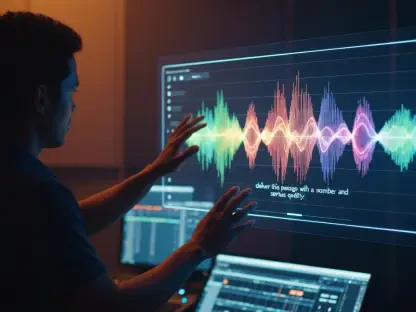Imagine stepping into a home where floors clean themselves, the refrigerator customizes your sparkling water, and the yard maintains its pristine look without lifting a finger. That’s the captivating vision presented at IFA 2025, held in Berlin as one of the world’s leading trade shows for electronics and home appliances. This year’s event showcased a remarkable array of smart home technologies that prioritize practicality over mere novelty. Designed to address the everyday challenges of busy households, these innovations focus on saving time, enhancing comfort, and streamlining mundane tasks. From automated cleaning devices to intelligent kitchen appliances, the emphasis is on creating seamless, efficient living spaces that adapt to individual needs. This exploration dives into the standout products and trends from the show, highlighting how they are set to redefine modern home management with cutting-edge solutions.
Revolutionizing Household Efficiency
Advanced Cleaning Technologies
At IFA 2025, cleaning technology took a significant leap forward with devices engineered to minimize effort while maximizing results. Leading the charge are solutions like the Tineco PURE ONE A90S and FLOOR ONE STATION S9 Artist, which redefine floor care with features such as StreakFree Technology for quick-drying, spotless surfaces and self-cleaning capabilities using high-temperature steam. These cordless floor washers cater to households dealing with frequent messes, offering quiet operation to avoid disruption and intuitive displays for real-time cleaning updates. Their design focuses on tackling stubborn stains and maintaining hygiene without requiring constant user intervention, making them ideal for anyone seeking to reduce the burden of household chores. This level of automation signals a shift toward tools that handle the dirty work independently, allowing more time for personal priorities.
Another standout in the cleaning category is the Mova Z60 Ultra Roller Complete, a robot vacuum and mop combo built for versatility across various surfaces. Equipped with HydroForce™ Technology for efficient water management and specialized brushes to handle pet hair, this device addresses the needs of homes with diverse flooring and furry companions. Its Self-Care Base Station automates maintenance tasks like dust emptying and cleaning, ensuring the unit remains ready for action with minimal input. This innovation reflects a broader trend of multifunctional tools that adapt to complex household demands, eliminating the need for multiple gadgets. By combining vacuuming and mopping into a single, hands-off operation, it exemplifies how technology can transform routine upkeep into an effortless process, freeing up valuable time in packed schedules.
Automated Outdoor Maintenance
Outdoor care also saw impressive advancements at IFA 2025, with tools designed to take over labor-intensive tasks like lawn maintenance. The Lymow One Robotic Lawn Mower stands out as a game-changer for homeowners with expansive or uneven yards. Capable of covering up to 1.73 acres daily, this device uses dual rotary blades and smart navigation for precise cutting, even on challenging terrain. Controlled via an app for scheduling and monitoring, it operates quietly to avoid disturbing the neighborhood. Such technology underscores the growing demand for automation in outdoor spaces, reducing the physical effort traditionally associated with yard work while delivering professional-grade results that enhance curb appeal.
Beyond just cutting grass, robotic mowers like this one highlight the integration of smart connectivity in outdoor tech. Features such as real-time updates and customizable mowing patterns allow users to tailor the device’s performance to specific lawn conditions without needing to be physically present. This hands-free approach addresses a common pain point for those with limited time or mobility, ensuring that maintaining a tidy exterior no longer competes with other responsibilities. The quiet operation further adds to its appeal, blending seamlessly into daily life without the noise pollution of traditional equipment. As automation extends beyond indoor spaces, it paves the way for a future where every aspect of home care can be managed with minimal effort, redefining convenience on a larger scale.
Enhancing Comfort and Security
Smart Kitchen and Wellness Solutions
Kitchen and wellness technologies at IFA 2025 demonstrated a clear focus on improving health and convenience through intelligent design. The Dreame FizzFresh™ Refrigerator, for instance, elevates hydration with a built-in SparklingBar that dispenses chilled sparkling water at adjustable fizz levels, paired with a dual-mode ice maker for versatility. Its sleek, fingerprint-resistant finish adds a touch of style to functionality, appealing to those who value both aesthetics and practicality in their appliances. Meanwhile, the Dreame Tasti™ AF30 Air Fryer offers a healthier cooking alternative, using advanced heat technology to reduce oil usage by 85% and cut cooking times significantly. These innovations show how smart tech can transform daily routines like meal prep into quicker, more nutritious experiences without sacrificing quality or taste.
On the wellness side, devices like the DREO Humidifier 717S and Whole Room Heater & Circulator 714 address indoor comfort with precision and care. The humidifier combines warm and cool mist options with a large tank for extended use, ensuring optimal air quality through customizable settings and quiet performance. In contrast, the heater delivers rapid, even warmth across spaces with safety features for worry-free operation, catering to colder months when consistent temperature control is essential. Both products tackle often-overlooked aspects of home life, such as humidity and heating, turning environments into healthier, more comfortable sanctuaries. This focus on personal well-being through technology highlights a shift toward holistic living, where smart devices contribute to physical health as much as they do to efficiency.
Intelligent Security and Entertainment Upgrades
Security solutions presented at IFA 2025 offer robust protection with minimal maintenance, as exemplified by the Dreame NAVO Elite 1 OutCam. This outdoor camera provides 2K resolution, extensive zoom capabilities, and AI-driven detection to differentiate between humans, pets, and other movements, ensuring accurate alerts. With 360-degree coverage and night vision, it delivers comprehensive monitoring for enhanced safety around properties. Such advancements cater to the need for reliable, low-effort security in busy households, allowing peace of mind without the hassle of constant oversight. The integration of smart detection technology reduces false alarms, making it a practical tool for modern home protection in an increasingly connected world.
Entertainment also received a boost with innovations like the Govee TV Backlight 3 Pro, which transforms viewing experiences through vibrant, customizable lighting. Featuring advanced color-matching technology and compatibility with major smart home ecosystems, this device creates an immersive atmosphere for movies or gaming. Its brighter output and precise synchronization with on-screen content elevate leisure time, turning ordinary setups into captivating hubs. This type of product reflects a growing trend of using technology to enhance personal enjoyment, focusing on small but impactful additions to home environments. By blending seamlessly with existing systems, it shows how smart tech can enrich downtime, offering tailored experiences that make relaxation more engaging and memorable.
Future Horizons in Smart Living
Seamless Integration and Connectivity
One of the most compelling trends at IFA 2025 was the push toward interconnected home ecosystems, where devices communicate effortlessly to create a unified experience. Many of the showcased products, from security cameras to lighting solutions, integrate with apps or broader smart platforms, enabling centralized control over various home functions. This connectivity allows for real-time adjustments, whether it’s scheduling a robotic mower or tweaking room humidity, all from a single interface. Such advancements point to a future where technology anticipates needs before they arise, crafting responsive environments that adapt dynamically to daily routines. The emphasis on seamless integration addresses the complexity often associated with multiple gadgets, simplifying management for users across diverse lifestyles.
This trend also underscores the role of artificial intelligence in enhancing device functionality, as seen in AI-driven features that learn user preferences over time. From security systems that refine detection accuracy to kitchen appliances that suggest optimal settings, these intelligent systems reduce decision fatigue by automating choices. The result is a home that not only responds to commands but also proactively supports its inhabitants, minimizing manual input. As connectivity continues to evolve over the coming years, from now through 2027, the potential for even tighter integration looms large, promising homes that are not just smart but truly intuitive. This direction highlights a pivotal moment in consumer tech, where the focus shifts from individual tools to cohesive, supportive networks.
Reflecting on Practical Innovations
Looking back, the array of smart home technologies unveiled at IFA 2025 painted a vivid picture of how far practical innovation has come. Devices that automated cleaning, enhanced kitchen efficiency, and bolstered security stood as testaments to a design philosophy rooted in solving real-world problems. Each product, whether it streamlined a chore or elevated personal comfort, contributed to a vision of living spaces that work smarter, not harder, to meet human needs. The emphasis on user-centric features, from customizable settings to hands-off operation, marked a significant step in making technology accessible and beneficial for all.
Moving forward, the challenge lies in ensuring these advancements remain affordable and widely adoptable, so their benefits reach diverse households. Manufacturers and developers might consider scalable solutions or modular designs to lower entry barriers, while continuing to refine AI and connectivity for even greater ease of use. For consumers, staying informed about emerging tools and their practical applications will be key to leveraging these innovations effectively. As the smart home landscape evolves, the focus should remain on balancing sophistication with simplicity, ensuring that the promise of a more connected, efficient lifestyle becomes a reality for many in the years ahead.









